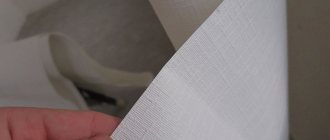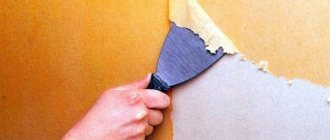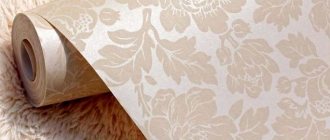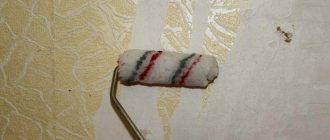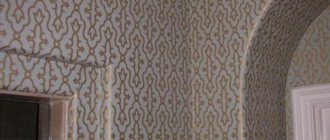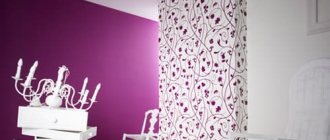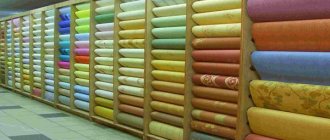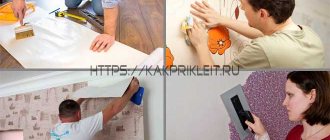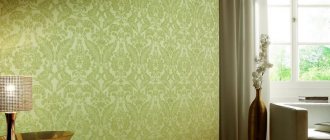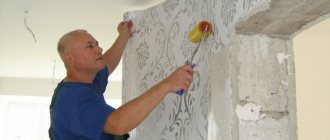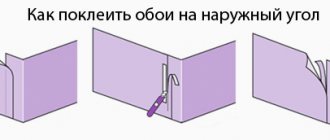When a brick wall becomes a decoration of a room
Initially, the presence of bare brick walls in residential and office interiors was associated with post-war hopelessness, but then it became fashionable. Now this decor is found in various design options:
- loft style, which is the main direction where brick is used as a decorative element;
- daring grunge;
- luxurious and fantasy neo-Gothic;
- spacious Scandinavian style and lively country, in which white masonry looks most appropriate;
- classical Gothic, which allows the use of brick to cover all walls;
- geometric and restrained minimalism, characterized by technical textures and materials.
Brick wallpaper in a loft interior
Country style interior
Typically, all walls are not covered with brick. In addition, this decor looks better in large rooms and requires good lighting.
Brick wall as an accent
Note!
Brickwork needs to be supported with natural textures, for example, wood, but it does not tolerate being adjacent to artificial elements quite well.
Otherwise, with proper placement and choice of color, brickwork can emphasize the softness of the interior, help in zoning the space, or become the central link in the decor of the room. By the way, the color of the brick can be not only traditionally white or red, which allows it to fit into rooms with a variety of color schemes and functionality.
Prices for various types of wallpaper for brickwork
Brick wallpaper
Why choose an imitation brick wall in a modern interior?
Various options for imitating brickwork are a favorite way to create an accent wall among famous designers working in loft, high-tech, fusion, country, and minimalist styles. But even this list of such conceptually different styles does not limit the possibilities of using this wall cladding. Anyone who wants to create an inimitable designer interior can use this technique - it will turn out just like in the photo.
Not everyone can afford to lay out a real brick wall, but creating an imitation using wallpaper is accessible to everyone
Certain interior styles simply cannot do without brickwork
A brick wall is amazingly eye-catching, although to some it appears “bare” or “rough.” But this “unfinished” cladding has a lot of adherents. The mass production of wallpaper with similar imitation, known since post-Soviet times, has greatly facilitated repairs.
Wallpaper "under masonry", which was in use about 15-20 years ago, did not differ in variety and quality. Red-brown rolls with and without ivy sprigs were on sale. Modern imitations of brick have undergone major design improvements in order to maximize the range of products.
Important! The decorative properties of the surface after wallpapering can be much higher than the masonry itself. Therefore, if you have a real brick wall that is not purely aesthetically pleasing, starting with plaster and wallpapering with a more suitable design is enough.
Previously, when the design concept involved a real brick wall, a real master of his craft was required to work with brick. Today you don’t need to have construction skills; it’s enough to have a little experience in wallpapering walls. A visual effect can be achieved when light plasterboard partitions are made during zoning - “brick-like” wallpaper creates the feeling of a real wall, similar to the photo example.
Light frame partition with brick-look wallpaper
Wallpaper featuring brickwork is used to decorate a wide variety of rooms.
A solid or fragmentary brick wall is a subconscious feeling of reliability, stability, and security. Somewhere inside everyone feels that “my home is my fortress,” regardless of whether it is a cottage, a dacha or an apartment. This was laid down in childhood - from the fairy tale about the three little pigs. An effective way to add expressiveness to any setting or creatively zone a large room - “brick wall” wallpaper in the interior.
See alsoWallpaper for painting, photo.
Brick as living room decor
In the living room, the use of brickwork is very appropriate. However, the color of the brick may vary. In this way, they usually decorate one wall or part of it, for example, some kind of niche. The rest of the wall covering is made monochromatic. An exception is, for example, Gothic. The main thing is to choose the right environment and set up bright lighting. It's good if the room has a large window.
Wallpaper with imitation brick in the living room interior
For natural red or white masonry, light, restrained tones are suitable as neighbors. Small accents can be bright, for example, pillows, armchairs, patterns on carpets, etc. An example of a living room with rich accents and exposed brick is a New British style room.
English interior style
A wall of gray and brown bricks fits well into a room with chocolate tones. In a classic living room, you can frame the fireplace with brick.
Red-brown wallpaper and fireplace
Features of styles
When buying wallpaper to match decorative bricks, a number of factors must be taken into account. The canvases must fit the overall style, matching the color schemes. In addition, the functional purpose of the room, its area, location, and window parameters are taken into account.
For each style solution, a certain type of wallpaper with brick imitation is suitable.
Loft
With the help of a non-standard combination of street style solutions and other trends, luxurious and unpretentious interior solutions are created at the same time. The main feature of an industrial space is a crumbling concrete surface and brickwork.
There is no need to turn the room into a dusty area. Manufacturers of modern building materials present to the consumer a huge selection of wallpaper that imitates brick.
The color range is wide; it is possible to accent one wall with darkish wallpaper, creating a smooth transition to beige or red brick. Walls finished in the same type will become a successful backdrop for interior design. White brick canvases look appropriate in an ascetic interior. Not only different shades are used, but also patterns. Among the most popular are herringbone brick masonry, with the remaining plaster.
Scandinavian
White wallpaper in the form of brickwork is quite common in a bright interior. With their help, the same type of room decoration is diluted. The main color scheme is left unchanged, and one wall is decorated with red or light brick to give the interior originality and comfort. Light brick wallpaper creates an excellent background for paintings and photographs. A gray brick wall is suitable for bright decors. Darkish wallpaper with 3D embossing will perfectly highlight the beauty of audio or video equipment.
To brighten up the monochrome, some areas are alternated with bricks of different shades.
Provence
This style is warm and calm, decorated in beige and sand tones; there may be imitation masonry with a layer of whitewash. Taking into account the purpose of the premises, they use smooth wallpaper, with pronounced relief lines, and photo printing. Small cracks, irregularities and slight wear add realism and perfectly imitate the roughness of the stonework of a village house. “Brick” wallpaper decorated with patterns looks beautiful. It is recommended to combine the rest of the walls with other wallpapers with checkered, floral and striped patterns.
Shabby chic
The interior in this style is decorated with objects long forgotten by experienced designers. Canvases that imitate brick are a frequently used building material in such rooms. Finishing with a brick texture can be light and is used only to accent one wall. In spacious rooms, wallpaper is zoned, using rolls with deliberately aged patterns. With such wallpaper it is allowed to combine other finishing materials that enhance the effect.
Brickwork in the kitchen
In the kitchen or in the kitchen area of the living room-studio, brickwork is most often used for the apron. It is just a strip between wall-mounted and floor-standing cabinets. But you can decorate the entire work area. Whitewashed brick goes well with bright furniture and light wood facades, but calm colors in cool shades go well with red.
Brick wallpaper in the kitchen
If there is a dining table in the kitchen, then you can leave the brickwork on the wall adjacent to it.
Red brick wallpaper in the dining room
How to apply?
The plaster is applied using a spatula. The rows between the “bricks” are marked with the same, and the spaces between them are painted with the color that most successfully imitates the color of standard mortar. The “bricks” themselves are painted in the same way as the spaces between them. The advantage of this method is that your imagination will certainly not be limited by anything.
This imitation of brickwork in the interior will make your home completely different from others. Among other things, “substitution” can be done not only in relation to brick, but even natural stone. Of course, drawing it is a little more difficult, but all the effort will pay off many times over!
Hallway and bath
Passage rooms, for example, an entrance hall or a corridor, perfectly accept brick decor. In this case, you can cover all the walls. If the hallway is small, then a light brick covering will help expand the space.
Wallpaper in the hallway
A similar situation occurs in the bathroom. Brick will look original if you complement the decor with elements made of natural wood. And the metal surfaces of faucets and hooks are perfect for this finish.
Brick in the bathroom
Wallpaper with a brick pattern in rooms
When choosing wallpaper with a brick pattern, you may doubt whether it is suitable for a particular room? Undoubtedly, they will be suitable if you choose them correctly by color, type of lighting and area of the room to be covered. The light tone of brick wallpaper is universal; the wallpaper is suitable for both home, offices and public institutions.
Dark brick wallpaper cannot be glued in the following rooms:
- In the room for relaxation and rest;
- In the bedroom;
- In the bathroom.
Dark tones of brick wallpaper fit into every interior when properly combined with furniture, but are more suitable for halls, hallways, living rooms, and kitchens.
With a creative design approach to decorating a room with brick wallpaper, it is possible to achieve a harmonious look for the room even with dark brick wallpaper.
Will brickwork ruin the comfort of the bedroom?
It is believed that a brick wall can make the interior of a bedroom heavier. But it is not so. When placed correctly, brickwork will emphasize the softness of the bedroom. Usually the wall at the head of the bed is decorated with brick. You can even create a niche from plasterboard or decorate the wall with paintings and shelves. A soft bedspread, light curtains or a bedside rug in muted colors will help soften the rough design.
Such a wall can serve as a separation of the sleeping area from, for example, the working area. And in a teenager’s bedroom, even standard red or gray bricks are appropriate. They will convey the desire for freedom characteristic of this difficult age.
In fact, the possibilities for using brick decor are enormous. But they must be used with caution. For this reason, for do-it-yourself repairs, you need to choose a material that is not expensive and easy to install.
Tips for use
Wall covering that imitates brickwork is universal and is perfect for decorating not only living rooms, but also public places. Pasting walls with such wallpaper allows you to quickly change the interior, avoiding serious financial expenses for repairs.
A room decorated with wallpaper to resemble a brick wall looks unusual, associating it with a garage box. For this reason, such material is used to highlight central areas or form accents. The question arises: what wallpaper or other materials should we combine brick-like canvases with?
A simple option is a combination of such wallpaper with paper canvases.
Let's consider several options for combining with imitation brickwork:
- a solution that combines simple red brick and a light background in a sleeping area will seem unexpected;
- combine wallpaper of various shades with striped prints of the same tones. The striped pattern visually adjusts the proportions of a small room;
- Soft white brick wallpaper looks great with a coffee shade. There should be a minimum amount of furniture, because the light design is spoiled by “extra” objects that overload the space;
- What wallpaper goes with gray tones? It looks great with a snow-white background. This design is successfully implemented in a spacious room with good lighting.
Here are examples of materials with which brick-like wallpaper can be combined:
- with a surface finished with natural stone or its imitation;
- with wood. The texture and brickwork go well together;
- with glass and chrome items that are often found in modern kitchens;
- with a laminate that imitates an old floorboard, oak or pine;
- with a surface covered with plaster mortar.
What is the advantage of wallpaper with brick imitation?
Only a few rooms can boast of a real brick wall, and often this building material is covered with plaster, which is labor-intensive to remove. It is not advisable to erect a new brick layer, as it will make the structure heavier and steal space.
As an alternative, you can use tiles, facing bricks or patterned wallpaper. The latter option has several advantages.
- Wallpaper is the most budget option.
- They are the easiest way to cover the walls yourself.
- It takes a little time to hang the wallpaper and dry the glue.
- They do not create additional load on the walls and ceilings, and also will not eat up space.
- If necessary, the wallpaper can be easily removed.
- This material is not cold, unlike natural brick. This is especially true for bedrooms.
- The market offers a variety of colors and textures of wallpaper that imitate brickwork.
Embossed wallpaper
Note!
Products made to resemble old bricks with chips and unevenness look better. The image of a fresh brick wall reveals the unnaturalness of the material.
3D wall stickers imitating brickwork
To imitate brick, paper, vinyl, non-woven and self-adhesive wallpaper are suitable. The choice depends not only on your preferences, but also on several other factors indicated in the table.
| Wallpaper type | Factors associated with their use |
| They help save your budget. An excellent option for decorating niches. |
| Thanks to the volumetric structure, they imitate brick well, so they are suitable for large and well-lit rooms. They are easy to clean, so they are suitable for kitchens and corridors. They have invisible joints. They emit formaldehyde, so they require good ventilation and are not suitable for bedrooms. |
| They convey texture well. They allow air to pass through and do not emit toxic substances, so they are suitable for bedrooms. They can be painted in any color. Non-woven fabric hides small defects in the wall. |
| Easy to use, as they do not require the application of glue. They are moisture resistant, so they can be washed. This property is ideal for kitchens, bathrooms and hallways. |
Advice!
To protect the wallpaper in the kitchen work area from dirt, you can cover the apron with special glass.
Types of brick wallpaper
The brickwork in the interior, although it looks rough, attracts attention. This cladding will perfectly complement the loft, hi-tech, minimalism, and fusion styles. A solid or partially brick wall creates a feeling of reliability and safety. At the same time, choosing wallpaper is much easier than finding the corresponding stone. Unlike the original material, the imitation does not cool down and does not seem cold upon contact, which allows it to be used even when decorating a nursery or bedroom.
There are several types of wallpaper that differ in color, texture, pattern, which looks like large or small bricks. However, the main criterion by which they are separated remains the material used in manufacturing. There are paper, vinyl, non-woven models. Each option differs in quality characteristics and has its own advantages and disadvantages.
Vinyl
Vinyl wallpaper is a structural canvas consisting of two layers. One of them is made from paper or non-woven fabric, the second from polyvinyl chloride (PVC). Based on the type of surface, smooth and embossed models are distinguished. According to the degree of moisture absorption, all types are divided into ordinary and moisture-resistant. Depending on the type of coating, all types are divided:
- Smooth. Vinyl film applied to a paper or non-woven base has photo printing.
- Dense. They are characterized by poor breathability and resistance to humid environments. The base, consisting of three-layer paper, is covered with evaporated polyvinyl chloride, processed using a special technology.
- Foamed. The top layer has a relief surface. PVC applied to the base is subjected to heat treatment, as a result of which it foams.
The main advantages of wallpaper include:
- Good imitation of brickwork relief;
- Resistance to sunlight;
- Easy installation;
- High wear resistance;
- Long service life;
- Practicality, they can be cleaned and washed with detergents and water.
Before using a cleaning product, you should test it on a separate piece of the selected finishing material to ensure their compatibility and not completely ruin the fabric.
Flaws:
- Poor air permeability, which can lead to the formation of mold and mildew;
- Contains formaldehyde and may cause allergic reactions.
Paper
Among the huge selection of models, paper wallpaper remains the most popular in terms of price and quality. These are environmentally friendly products; in some situations there is no alternative to them, for example, they are indispensable for people suffering from allergies. Manufacturers produce two types of facing materials: simplex (single-layer), duplex (two-layer). Having chosen this option, you should take into account all the positive and negative aspects. The advantages of using wallpaper include:
- Low cost in comparison with other models;
- Good ability to pass moisture and air. The walls do not become damp, fungus and mold do not form on them;
- Simplicity of installation and dismantling work;
- Wide variety of colors and brick patterns.
The disadvantages of this type include:
- Burnout from exposure to sunlight;
- The brickwork pattern on a flat surface looks fake;
- Poor wear resistance, short service life.
- Instability to wet environments.
With 3D effect
3D wallpaper will give any interior an unusual look and help create a light, cozy atmosphere. They are made of paper, non-woven, vinyl fabric with a large-format pattern applied, modeled on a computer. Special particles that reflect light make the image three-dimensional. Among the main advantages of the products are the following:
- The most realistic image of brickwork;
- Moisture resistance, can be used in rooms with high humidity;
- Made from environmentally friendly raw materials, they do not emit harmful substances;
- Resistant to sunlight;
- Easy to maintain, wet cleaning of the surface is possible.
Flaws:
- High cost of the finished product;
- Not suitable for use in small rooms, they narrow the space;
- The drawing quickly gets boring, they should not be glued in the bedrooms, it is better to give preference to the living room.
Non-woven
This type of canvas is also called improved paper. There are two main types of this wallpaper: purely non-woven, on a semi-synthetic non-woven base. The first are several layers of non-woven fabric glued together. The second option can be covered on top with paper, textiles, or polyvinyl chloride. The main advantages of these products include:
- Vapor permeability, the material is breathable, prevents the formation of fungus and mold;
- Environmentally friendly raw materials are used in production;
- Simple installation; no careful surface preparation is required before gluing;
- Wallpaper can be pasted on any surface;
- Masks small defects on the walls;
- Moisture resistant, do not lose shape when wet and dry;
- Retain heat and partially provide sound insulation;
- Resistant to fading in the sun.
Flaws:
- Products that do not have a vinyl coating cannot be cleaned with aggressive detergents;
- Attract dust;
- They have a high cost.
How to glue wallpaper under a brick
Covering a wall with wallpaper that imitates brickwork is no different from working with ordinary wallpaper decorated with a pattern. It is important to properly prepare the walls and join the panels.
Preparing the wall
The smooth surface of the walls ensures high-quality wallpapering. Before you begin preparation, you must remove the old coating, if any.
New wallpaper can transform the interior and even radically change it. They need to be glued onto a previously prepared surface from which the remains of old wallpaper have been carefully removed. To quickly remove old wallpaper from walls, use one of the methods described in detail on our website.
To plaster walls for wallpapering you need:
- gypsum plaster;
- finishing gypsum putty;
- primer;
- metal beacons;
- rollers, brushes, brushes;
- wide and narrow spatulas, scrapers, finishing spatula, plaster trowel;
- grinder or sanding float;
- buckets for mixing mixtures;
- mixer;
- rule;
- laser level;
- rolling container for primer.
Note!
It is recommended to take the mixtures and primer from the same manufacturer.
Mixtures for preparing walls
Step 1. Remove dust from the surface of the walls with a brush and apply a primer with a brush or roller. The number of layers depends on the wall material. For hygroscopic surfaces, apply two coats of primer immediately one after the other.
Application of primer
Step 2. Install beacons. To do this, mix gypsum plaster with water in a large container.
Pouring dry mixture into water
Stirring until smooth
Apply the resulting paste in several places in a straight line from top to bottom.
Applying “heaps” for attaching beacons
Attach the beacons to it, focusing on the laser level, and fix them.
Fixing beacons
Step 3. After the plaster on the lighthouses has dried, apply a primer.
Pouring soil into the tray
Applying soil to lighthouses
Step 4. Apply the plaster to the wall with a spatula and smooth it using the rule, focusing on the beacons.
Mixing mortar for plastering walls
Throwing mortar with a spatula
The rule should be moved from bottom to top, based on the beacons
Step 5. Wait until the solution begins to set. The time must be indicated on the original packaging. In practice, the plaster should be soft, but not sticky. As a rule, make trimming to remove irregularities, and plaster the resulting errors.
Step 6. Remove the beacons and cover the recesses with solution.
Removing beacons
Sealing recesses with mortar
Step 7. Once dry, use a wide scraper to trim to remove any rough spots.
Trimming small irregularities
Step 8: Prime twice.
Step 9. After the primer has dried, prepare a solution of finishing putty and apply it to the wall with a finishing spatula. The direction of puttying is perpendicular to the application of gypsum plaster.
Mixing the finishing putty solution
Applying putty in a thin layer
Step 10. After drying, sand under a developing light, that is, under a flashlight turned on above the wall.
Step 11. Remove dust from the wall with a brush and prime again.
Applying primer before gluing wallpaper
Prices for deep penetration primer
Deep penetration primer
Video - Basics of plastering work
The surface is ready for wallpapering. Now you need to correctly calculate the wallpaper.
- Measure in meters the length of the wall or area covered with wallpaper that imitates brickwork.
- Measure the ceiling and add 0.05 m above and below to the resulting value, that is, 0.10 m (this is the margin for trimming).
- To the resulting value, add the length of the repeat, that is, the step through which the pattern is repeated. This value is indicated on the packaging. The total amount is the length of the canvas.
- Divide the first value by the width of the roll, which is usually 0.53, 0.7 or 1.06 m. Round the result up. This is the required number of cut sheets.
- Calculate how many whole strips you can get from one roll. To do this, divide the length of the wallpaper in the roll by a third value. Round the resulting result down.
- Divide the number of cut sheets by the number of sheets from one roll. This will give you the required number of wallpaper packs.
Note! It is recommended to buy a spare roll. In addition, all wallpaper should be from the same batch indicated on the package, this will help to avoid differences in shade.
All wallpaper must be from the same batch
Calculator for calculating the required amount of wallpaper on a wall
Go to calculations
In addition to the wallpaper itself, you will need:
- glue corresponding to the type of wallpaper, if it is not self-adhesive;
- brush-brush
- construction knife;
- tape measure, pencil;
- hydraulic level;
- bucket and water for diluting glue.
Everything you need for work
Wallpaper glue
Helpful advice
For convenience, you can purchase a special soft wallpaper spatula and a roller for leveling the wallpaper.
How to glue paper-based wallpaper
When gluing paper wallpaper, the glue is applied to the canvas itself. Gluing paper wallpaper or canvases with a paper base follows the same principle.
| Step, No. | Description |
| From the point where you started gluing, measure a distance equal to the width of the roll. Thus, make several vertical marks, which are connected with a pencil line using a large hydraulic level. This is a vertical for starting wallpapering. |
| Dilute the glue in water in the proportions indicated on the package. |
| Measure the height of the wall with a tape measure, add 5 cm above and below and the height of the rapport. This will give you the length of one canvas. Cut the strips, marking the number on the top of each with a pencil. |
| Apply glue to the wallpaper, moving the brush or roller from the center to the periphery. |
| Fold the top and bottom edges of the fabric with the coated side inward. Leave for 5-10 minutes to soak. |
| Apply the first sheet so that its right edge coincides with the vertical. |
| Smooth the strip from the center to the edge with a spatula, gluing it to the wall. |
| Remove excess wallpaper from top and bottom using a utility knife. |
| Join the second one to the right edge of the first canvas, adjusting the pattern, and glue it to the wall, smoothing it out. Trim off the excess. |
| If there is glue on the seams, blot it with a damp cloth. |
Continue using this pattern until you have covered the required space.
